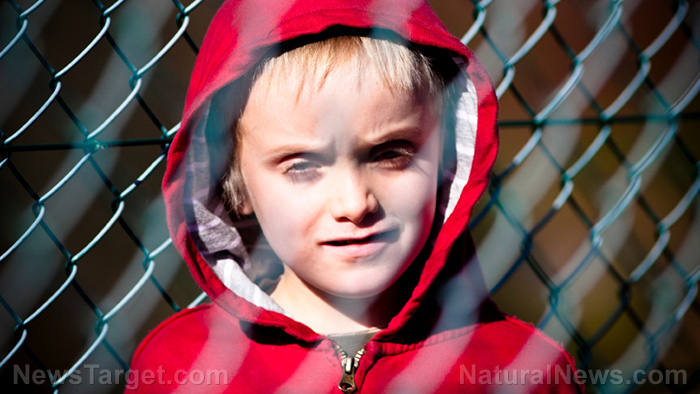
Attention Deficit Hyperactivity Disorder – causes, side effects and treatments at NaturalPedia.com
Thursday, January 11, 2018 by Jhoanna Robinson
http://www.naturalpedia.com/attention-deficit-hyperactivity-disorder-causes-side-effects-and-treatments-at-naturalpedia-com.html

Attention deficit hyperactivity disorder (ADHD) is a condition that affects three to five percent of all American children, making them absent-minded or forgetful, and causing them to lose things. According to the American Psychiatric Association, there are three basic forms of ADHD, namely, inattentive, hyperactive-impulsive, and combined.
ADHD comes into a child’s life no later than the age of 12. Some medical researchers say that around 40 to 50 percent of ADHD-addled children will have (typically non-hyperactive) symptoms well into adulthood.
Children with ADHD have brains that are three percent smaller than children who are not afflicted with the disorder. It is important to note, however, that intelligence is not affected by brain size. Certain areas of the brain are also smaller in children with ADHD, such as the frontal lobes, which are involved in concentration, impulse concentration, impulse control, inhibition, and motor activity.
According to the Journal of Attention Disorders, boys tend to get distracted more easily than girls. However, girls with ADHD may become victims to more internal issues, such as anxiety and depression, especially while they are growing up.
Among the contributing factors of ADHD include:
- Neurophysiology – which suggests complex distinctions in brain anatomy, electrical activity, and metabolism;
- Genetics – gene mutations may be present;
- Drugs – the child’s mother may have used nicotine or other substances when she was pregnant with the child;
- Lead – the child may have been exposed to lead, thereby affecting behavior and brain chemistry;
- Childhood post-traumatic stress disorder – this can be a factor as to the development of ADHD;
- Nutrition, although it is still controversial whether ADHD can be linked to sugar consumption; and
- Brain injuries.

Known side effects of attention deficit hyperactivity disorder
A child with ADHD can be observed as often giving into impulsive behaviors and inappropriate actions (fidgeting, inability to keep still) or restlessness. He or she exhibits movements or actions that could later on be classified as disruptive or, in worst-case scenarios, even harmful to others in his or her surroundings.
Children with ADHD find it difficult to focus and concentrate, often leading to problems at school. They tend to easily forget instructions and have such a short attention span that they fleet from one task to another without completing anything in between.
Children with ADHD also have organizational problems. They are not keen on doing tasks that require continuing mental effort, such as school work. They find it burdensome to wait for their turn and easily lose patience. Another sign that a child may have ADHD is if he or she talks too much and gets distractedly easily by even the smallest stimuli.
ADHD-addled children also report feeling out of control and helpless, and experience sudden bouts of loneliness. IN some extreme circumstances, they even find it difficult to go about playing or engaging in activities quietly.
Body systems harmed by attention deficit hyperactivity disorder
Since ADHD disrupts a child’s learning capability, it can be said that the disease is bad for the nervous system. It can cause problems for the person in terms of academic, occupational, or social functioning.
Food items or nutrients that may prevent attention deficit hyperactivity disorder
Fruit shakes are good for children with ADHD – try giving them mangoes and pineapples. Feed them with food rich in protein as protein boosts brain function and reduces hunger-induced mood swings.
Treatments, management plans for attention deficit hyperactivity disorder
With constant behavioral therapy, a child with ADHD may subsequently manifest a reduction of his or her symptoms. However, it would help a lot if, along with the treatments, parents of children with ADHD would aspire to do the following:
- Practice consistent routines at home and in school, such as providing a fixed time of picking up the children, or initiating a structured set of day-to-day activities, such as brushing the children’s teeth or telling them bedtime stories at night.
- Limit television time, so as not to encourage distracted behavior.
- Encourage children to get involved in a sport or hobby to practice their sense of concentration.
- Give your instructions clearly and make them simple. Talk in a calm manner.
- Make sure you have the child’s full attention when you talk. After saying your instructions, ask them to repeat what you said to make sure they understood you.
- Don’t be shy to lavish praises on your child whenever he or she did something appropriate, to instill in them that good behavior begets rewards and appreciation.
- Impose disciplinary measures for behaviors that you deem inappropriate.
According to the Centers for Disease Control and Prevention, early intervention can decrease behavioral problems, help with social skills, prevent failures in finishing tasks, and improve school grades.
Prescription medication, such as stimulants, are also given to children with ADHD. However, such stimulants can cause side effects in some patients, including fatigue, insomnia, and irritability. The good news, according to the McGovern Institute for Brain Research, is that 60 percent of people exhibit favorable response to the first stimulant they are prescribed.
Where to learn more
- Attention deficit hyperactivity disorder, ADHD, has a simple cause: poor nutrition and food additives
- GAPS diet claimed to relieve food allergies, autism, ADHD, depression and more
- Confirmed science shows that vaccinated children have 420% higher risk of ADHD compared to non-vaccinated kids
- Top 5 reasons “ADD” and “ADHD” are misdiagnosed and often NOT actually disorders at all
- ADHD: Misdiagnosed and overmedicated
Summary
With constant behavioral therapy, a child with ADHD may subsequently manifest a reduction of his or her symptoms.
ADHD comes into a child’s life no later than the age of 12.
Children with ADHD have brains that are three percent smaller than children who are not afflicted with the disorder.
Sources include:
Tagged Under: Tags: Attention deficit hyperactivity disorder





